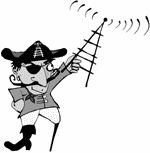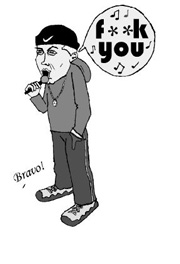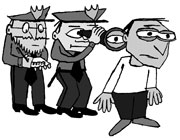The pirates are coming! The Federal Communications Commission’s recent decision to license noncommercial low-power FM or “pirate” radio stations heralds a new kind of medium, with potentially a greater diversity of news, music, and local information—but it’s one that won’t be accessible to a lot of people.
The 3-2 commission vote to go ahead with low power came after a full decade of agitation by the “pirate” radio movement, in which hundreds of unlicensed stations across the country courageously defied federal regulators to give their communities a voice. The FCC’s accession is a de facto admission that the pirates were right: Technological advances made the ’50s-era standards the FCC kept for protection of broadcast signals obsolete. Its continuing refusal to allow access to the public’s airwaves to anyone other than high-power corporate broadcasters was thus a violation of the First Amendment. Several lawsuits on those grounds were winding their way through the courts, and it’s not clear whether the FCC would have won. Between the legal threat and the David vs. Goliath public relations bath the regulators were taking, the FCC backed down.
The new regulations include two classes of low-power FM signals, with powers of 1-10 watts and 10-100 watts. The 10 watters will have a signal range of 1-2 miles; a 100-watt station would reach about 3 miles. Stations will be noncommercial (though, as with higher-power noncommercial stations, underwriting will be allowed) and will be limited to owners that have no other media interests; other radio stations, TV, or newspapers will be unable to own the new stations. Each licensee may own only one station in a given community, but may own up to 10 stations nationwide. The first round of applications for the 100-watt stations will be in May. The decision, welcome as it is, isn’t good news for everyone. The new low-power service was vigorously opposed by the National Association of Broadcasters, ostensibly on the grounds that the stations would interfere with existing FM signals. The FCC caved on this crucial point, decreeing that the new stations would have to protect existing ones up to the third adjacent channel rather than the second adjacent. (For example, if an existing station broadcasts on 93.3 FM, the standards prohibit stations on 93.5 or 93.7 FM.) Since stations are commonly spaced every four channels in large cities, this means that few or no frequencies will be available for the new low-power stations in many metro areas.
In Seattle, only one frequency—103.1 FM—is clearly eligible for the new stations. Depending on the protection afforded other low-power noncommercial stations, 91.9, 104.3, 104.5, and 104.7 FM are also possibilities.
Seattle will clearly get at least a handful of new stations, but nothing close to what the demand is. At least a half-dozen pirate radio projects have attempted to broadcast in Seattle in recent years, most notably FUCC and Free Seattle Radio. Given the technical and legal difficulties of pirate radio—the equipment is necessarily homemade and almost always unreliable—far more parties, whether they be political groups, churches, community councils, schools, unions, clubs, or whatever, will be applying for the new licenses. The FCC will use a point system, with criteria like local ownership and number of proposed broadcast hours, to decide among mutually exclusive applications.
In large cities, where it’s hardest for local groups to crack the media, the demand will be greatest—but the fewest spots will be available. Thus, a decision which could potentially open up a whole new medium, allowing neighbors to broadcast to neighbors and flying in the face of the corporate media consolidation of recent years, is fatally flawed.
The other problem with the FCC’s decision is its bar of licenses to micropower stations that have already been on the air. In some cases, such as Springfield, Illinois’ Black Liberation Radio or Free Radio Berkeley in the Bay Area, these pirates have become established community fixtures. Categorically refusing them licenses at this point is not only petty, but brings up the same First Amendment issues that spooked the FCC into acting in the first place.
No matter; such stations will undoubtedly find someone else to front for their license applications (though in the Bay Area, the band is too crowded to allow any low-power stations under the FCC’s new guidelines.) The lid is off Pandora’s box; it’s now legal, with a license, to put an FM station on the air for as little as $500 to $1,000. The major barrier to illegal broadcasting is now gone: reliable low-power transmitters will be legally available on the market. (Broadcast Electronics has already announced it will sell the transmitters.) Regardless of the technical restrictions the FCC has put on these new stations, the flood will come, legal or not. As the world’s billions of Web pages have shown, lots of people have something to say. Now, with low-power FM, they’ll have a chance to say it. And, with a decision that did not go far enough, the FCC’s hand will simply be forced by the next generation of pirates.
A new kind of pitch
“The line is busy. . . .” So begins US West’s new replacement for the venerable busy signal. It replaces the familiar tones with a 15-second pitch for a call back when the line is available (“for just 75 cents”). Commercials are everywhere now. What’s next? A mandatory ad before your call is connected? I probably shouldn’t suggest it, someone at the phone company is doubtless reading this. . . .







